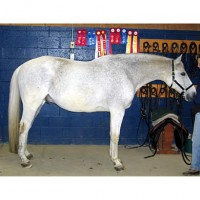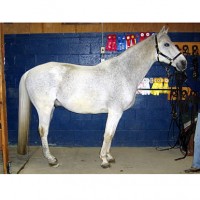
Gravity. It’s not just a good idea… it’s the law! This goes for horses and dogs as well as people. Pretty much all activity on earth is influenced by gravity, and the forces generated by gravity are the primary source of most athletic injury. However, most injuries aren’t caused by running or jumping, as you would think. They actually originate with how the person or animal uses their body while standing. In horses, this is especially critical, because they spend 20-22 hours a day standing: standing and eating, standing and sleeping or just plain standing.
What goes into posture?
Did you ever think about what it takes to stand up? You have to organize your legs, joint by joint, engage your spine, support your head and at the same time, keep the whole apparatus from falling over. All these tasks are done unconsciously by postural control centers in the brain, which process information about the body’s position in space. The nerves that receive information and take it to the central nervous system are called afferent nerves, and a special class of them are known as “proprioceptors.” Proprioceptors tell the brain where different parts of the body are: feet on the ground, head in the air, how much each joint is bent, etc. The most important information needed to generate posture comes from the position of the head and upper neck, the contact between the feet and the ground surface, and the position of the temporo-mandibular joints (TMJ), or jaw joints. These areas are very rich in proprioceptors; information transmitted to the postural control centers from these three regions will generate the correct standing posture needed to keep the animal upright.
Normal and compensatory posture

When a horse is standing normally, on level ground, all four cannon bones are perpendicular to the ground, like a table. The equine anatomy is adapted so that this posture is the most energy efficient. Any other posture is a compensatory posture, which takes more muscular energy to maintain, and puts strain on tendons and ligaments. There are normal, appropriate compensatory postures, such as when a horse stands uphill, or has an injury on one leg and shifts its weight to the other three legs. More often, we see abnormal compensatory postures, which are created by distorted information coming in to the postural control centers from the neck, feet or TMJ.
What causes compensatory posture?
Though they are the same genetically and physiologically, most domestic horses live in a world that is quite different from that of the wild horse. Instead of wandering the range all day grazing, our horses stand all day on wood chips in a 10’x12’ room, get a couple of meals of high calorie food, and exercise — if they are lucky — one to two hours a day. They have restraints (halters, bridles, cross-ties) on their upper necks, depend upon a farrier to trim, and sometimes put shoes on their feet, and once a year, a vet or an equine dental technician files down their teeth. All these changes in the natural ecology of the horse are part of the compromise of living among us humans. We do the best we can for our horses, but sometimes it isn’t quite good enough. Inadequate exercise and lack of appropriate ground surface changes a horses hoof growth and shape. Farriers do the same, sometimes making the hooves better and more functional, sometimes inadvertently making them worse. Eating small amounts of grain rather than large amounts of hay or forage, not only alters their digestion, but changes the way a horse grinds its teeth, affecting the position of the TMJ. Getting shanked, or pulling against cross-ties, can damage the delicate muscles of the poll. All these things will contribute to abnormal posture by distorting the neural signals that inform the brain about the body’s position in relation to gravity.
How does this work?
One of the most common causes of abnormal compensatory posture is imbalanced hooves, especially long toes. When a horse has excessive toe length, it stretches the flexor tendons, and puts pressure on the heel of the foot. The same thing would happen if a horse stood facing up a hill. With long toes, the brain gets confused, and thinks the body is on a hill, so the horse puts its front legs back in relation to its body. But since it is actually on level ground, if it leaned forward, it would fall on its nose, so the hind end must counter-balance. The result is the common compensatory posture we call “goat-on-a-rock”, where both front and hind legs are camped in. In this posture, the horse’s weight is pitched to the rear, standing heavier on its hind end than its front end. Normally a horse carries 55% of its weight in the front and 45% in the rear.
Chronic compensatory posture of this type can be the primary initiating cause of sore backs and hind limb lameness, as well as heel pain (sometimes called navicular syndrome). Back pain comes because the long muscles of the back are overworked to hold the body in an abnormal position. Hind limb lameness can be the result of carrying an inappropriate amount of weight in the hind end, overloading the hock and stifle joints, causing premature arthritis. Heel pain can develop from always rocking back on the heel of the foot, which crushes the digital cushion and damages the navicular bone. Amazingly, many of these syndromes can improve when the horse starts standing up straight. The same postural abnormalities can also be caused by problems with dental occlusion or injury to the poll.
How can I recognize if my horse’s foot balance is abnormal?
Take a ruler and measure the width of each hoof’s frog at its widest part, which should be the weight bearing part of the heel (the end of the shoe). In a horse with normal posture the front frogs will be wider than the hind frogs. Now, take your ruler and find the widest part of the entire hoof. A healthy hoof tends to be round, not oval, or spade shaped. The widest part of the hoof is the center of the hoof, from front to back. A horse’s heel support should be at the widest part of the frog. So, if heel to center line is one half the length of the foot, there should be an equal distance from the center to the toe “breakover”, which is the last part of the foot to leave the ground. If your horse has more foot in front of that center line than behind, its toes are too long. Ask your farrier to bring the heels back to the widest of the frog, and put the breakover the same distance as from the heels to the center of the foot, also called the “bridge”. This will balance the foot from front to back, so that the horse can bear weight evenly. If your horse has had long toes for a long time, it may take a few days to a few weeks for it to adjust to its new trim. Hang in there — the improvement will be worth it!
What else can I do to improve my horse’s posture and health?
Good dental equilibration is essential for the horse, whether an elite athlete or best friend. Find a veterinarian who specializes in dentistry, preferably one certified by the IAED (International Association of Equine Dentists), and make sure that your practitioner of choice will equilibrate both front teeth (incisors) and check teeth (molars). Most horses should have a thorough oral exam once a year. If your horse is sensitive at the poll, has a stiff neck or is head shy, it may benefit from someone with specialty training in veterinary manipulative therapy, either chiropractic or physical therapy. Once your horse can generate and maintain a normal standing posture, it should be able to heal itself from most body strains cause by poor hoof balance, dental malocclusion or poll dysfunction. Sometimes, when a horse has abnormal posture for a long time, it may need some help reprogramming its system. You can try to find a practitioner trained in Postural Rehabilitation at the website below.
Remember, a horse will be healthiest and happiest if it can live like its wild cousins. Give it lots of turn out, feed hay free choice on the ground (not in a hay net or trough), and go barefoot if possible. If your horse lives in a stall most of the time, make the stall as level as possible, so it doesn’t have to stand on peaks and valleys all day long. Horses are highly social, and become stressed if deprived from social interactions with other horses. Domestic horses live the good life in many ways — free food, safety from predators, shelter from the wind and rain. We can go a long way to mitigate the disadvantages of living among humans once we recognize the problems and their sources.
Dr. Karen Gellman is a graduate of Cornell College of Veterinary Medicine, and has a doctorate from Cornell in animal locomotion biomechanics. She has advanced training and certification in veterinary acupuncture and veterinary chiropractic. She has also studied physical therapy techniques with some of the leading equine physiotherapists in England and Canada. She teaches internationally about posture, complementary therapies and biomechanics to horsemen, veterinarians and physical therapists. She also is involved with both clinical and basic science research about posture in horses, dogs and humans. Learn about her work and upcoming events at www.equinesportsmed.com, or find a Postural Rehabilitation practitioner at www.posturalrehabvets.com.
Great article. We do need to spread the thinking that horses were not designed to live in solitary confinement, in small spaces, with limited forage. One question though – why do you feel free choice hay should not be fed with nets or troughs? I’ve found the nets to be working quite well, especially for horses that are not yet used to free-feeding and too likely to gorge.
I admire and embrace your findings but disagree with your statement about not feeding from a hay net. In some instances when done with a natural feeding model in mind, the hay nets are acceptable…we leave our small mesh hay nets on the ground with forage hay 24/7. The horses pull the strands out from the slow feed mesh in small mouthfulls…very similar to the way horses bite each mouthfull off in the wild… it is the closest to that same way of feeding – not leaving large piles on the ground. It also engages their prehensile lips in a similar fashion to grazing. Please consider condoning this method of feeding free choice hay as well. What are your thoughts?
Leigh